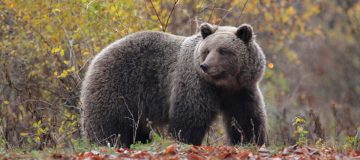By adding new Slovenia-based offerings to its growing portfolio, the European Safari Company will contribute to bear conservation and drive nature-based tourism development in the country’s Kočevje region.

Bear conservation and nature-based tourism in southern Slovenia have been given a timely boost with the European Safari Company (ESC) adding Slovenian experiences to their growing portfolio. The new offerings centre around bear watching in the country’s heavily forested and picturesque Kočevje region.
Bears, wolves, lynx and a diverse range of other iconic animals all inhabit Slovenia’s wilder areas. This means the country has the resources to see nature-based tourism really establish itself over the coming years. As people learn to live alongside such species, and benefit from them, sustainable relationships are now taking off and flourishing.
“We are thrilled to be able to offer Slovenia as an exciting new destination,” says Simon Collier, Rewilding Europe’s Wildlife Tourism Manager and director of the European Safari Company. “It’s hugely gratifying to see sustainable nature-based tourism gain a foothold in Slovenia, and we are committed to supporting its ongoing development.”
The new offerings follow a hosted trip which the ESC made to southern Slovenia last year. During the trip the team met with the local tourism department, hunting associations and forestry industry representatives to help with hide design and location, as well as the creation of tourist offerings, operating manuals and a best practice guide for wildlife watching. Going forwards the ESC will provide further support by helping to secure as many guests as possible for nascent nature-based businesses in the area.
“We saw how the combination of tourism models from other areas with new conservation ideas has led to an expanding opportunity in this beautiful corner of the country,” says Collier. “We also saw how people on the ground – from small business owners to nature guides – are proving critical to the long-term success of this new conservation movement.”

Burgeoning opportunities
A stunning land of snow-covered mountains, alpine lakes and huge swathes of pristine forest, Slovenia is an increasingly popular tourist destination. The country is already home to a booming mass tourism market, with popular hotspots such as the Kras cave region thronged with visitors in the summer months every year.
Developing sustainable, nature-based tourism as a new concept within such a market is undoubtedly a challenge, but has huge potential if done in the right way. Thanks in part to the LIFE DINALP BEAR project – a member of Rewilding Europe’s European Rewilding Network since 2014 – Slovenia has recently been earning itself a reputation as a destination for such tourism as well.

Slovenia’s burgeoning population of brown bears is part of the reason for this development. Recent DNA sampling studies, conducted as part of the LIFE DINALP BEAR project across Slovenia’s southern mountains and forests and along the Adriatic coast, revealed a healthy and growing population of these magnificent animals. While bears remain a heavily managed species in Europe and are still threatened by regimented, quota-style systems to control populations, this is widely regarded as positive news.
In conjunction with this, a new trend towards “bear tourism” in Slovenia is now emerging. The LIFE DINALP BEAR project is changing local mindsets and engaging stakeholders such as local hunting associations, the forestry industry and a range of European tourism partners in the planning and implementation of a “bear tourism” model.

The idea is to create a model which is sustainable, educational and has a positive impact on both nature and people. To date, the project has assisted in developing a new bear hostel in partnership with the municipality of Kočevje, engaged and partnered with local forestry and hunting associations who will “host” bear watching experiences, and are developing specialised wildlife watching hides.
“The chances of seeing bears in Kočevje are good, although with free-roaming animals there’s never a guarantee, obviously,” says Collier. “The area of development is a critical bear corridor and the support of local authorities and communities is vital to maintain it.”
